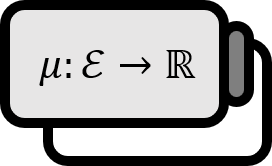In Measure Theory: Almost Everywhere and Almost Surely
Definition 1
If a function $f : E \to \overline{\mathbb{R}}$, excluding a set $E_{0} \subset E$ where $m(E_{0}) = 0$, has some property $P$, then $f$ is said to have property $P$ almost everywhere within $E$.
Notation
When talking about probability, almost everywhere is expressed as almost surely, and for conciseness, the abbreviation $$ f = g \text{ a.e.} \\ P(E) = 0 \text{ a.s.} $$ can be used.
Explanation
Simply put, viewing all points except for the null set as ‘almost everywhere.’ This concept might seem new only because it’s formally defined, but it’s something already known when learning about definite integrals in high school. Hence, if the upper and lower limits are the same, that integral was inevitably $0$, and whether endpoints were included or not was disregarded when calculating probabilities.
Basic Properties
- [1]: If $f : E \to \mathbb{R}$ is measurable and almost everywhere within $E$ $f = g$, then $g$ is measurable within $E$.
- [2]: If $f,g$ is measurable within $E$ and almost everywhere within $E$ $|f| , |g| < \infty$, then $\alpha f + \beta g$ is measurable within $E$.
- [3]: If $f,g$ is measurable within $E$ and almost everywhere within $E$ $|f| , |g| < \infty$, then $f g$ is measurable.
Proof
It’s beneficial to try proving these properties by hand at least once, though except for [3], they might not seem very interesting.
[1]
Let’s say $E_{0} = \left\{ x \in E \ | \ f(x) \ne g(x) \right\}$, then $E_{0} \subset E$ and $m(E_{0}) = 0$. For any given $c$, $$ \left\{ x \in E \ | \ g(x) > c \right\} = \left\{ x \in E_{0} \ | \ g(x) > c \right\} \cup \left[ \left\{ x \in E \ | \ f(x) > c \right\} \cap ( E \setminus E_{0} ) \right] $$, looking at each term on the right, since $\left\{ x \in E_{0} \ | \ g(x) > c \right\} \subset E_{0}$, $$ \left\{ x \in E_{0} \ | \ g(x) > c \right\} \in \mathcal{M} $$, since $f$ is measurable within $E$, $$ \left\{ x \in E \ | \ f(x) > c \right\} \in \mathcal{M} $$, and finally, $$ E \cap (\mathbb{R} \setminus E_{0}) = ( E \setminus E_{0} ) \in \mathcal{M} $$, thus $\left\{ x \in E \ | \ g(x) > c \right\} \in \mathcal{M}$ and $g$ is measurable within $E$.
■
[2]
If $\alpha = 0$, then $\alpha f$ is measurable and if $\beta = 0$, then $\beta g $ is measurable.
If $\alpha \ne 0$, as $f$ is measurable, for any given $\displaystyle {{c} \over {\alpha}}$, $$ \left\{ x \in E \ \left| \ f(x) > {{c} \over {\alpha}} \right. \right\} \in \mathcal{M} $$, if $\alpha> 0$, $$ \left\{ x \in E \ | \ \alpha f(x) > c \right\} \in \mathcal{M} $$, and if $\alpha <0$, $$ \left\{ x \in E \ | \ \alpha f(x) < c \right\} \in \mathcal{M} $$, hence, $\alpha f$ is measurable and, in the same way, it can be shown that when $\beta \ne 0$, $\beta g$ is measurable.
Now if $(f + g)$ is measurable, i.e., $\left\{ x \in E \ | \ f(x) + g(x) < c \right\} \in \mathcal{M}$, the proof concludes. Since both functions have finite values, for all $x \in E$, there exists a $c \in \mathbb{R}$ that satisfies $f(x) + g(x) < c$. Rewriting, $f(x) < c - g(x)$ and due to the density of rational numbers, there exists a $q \in \mathbb{Q}$ that satisfies $f(x) < q < c - g(x)$. Thus, $$ \bigcup_{q \in \mathbb{Q}} \left\{ x \in E \ | \ g(x) < c - q \right\} \cap \left\{ x \in \ | \ E f(x) < q \right\} = \left\{ x \in E \ | \ f(x) + g(x) < c \right\} \in \mathcal{M} $$
■
Strategy[3]**: The idea to show that $fg$ is measurable is summarized by one equation $\displaystyle fg = {{1} \over {2}} \left[ (f+ g)^2 - f^2 - g^2\right]$.
[3]
Since [2] already proved that the sum of measurable functions not diverging in value is measurable, it suffices to demonstrate that $f^2$ is measurable. Since $f$ is measurable, for all $c$, $$ \left\{ x \in E \ | \ f(x) > \sqrt{c} \right\} \in \mathcal{M} \\ \left\{ x \in E \ | \ f(x) < - \sqrt{c} \right\} \in \mathcal{M} $$, thus, $$ \left\{ x \in E \ | \ f(x) > \sqrt{c} \right\} \cup \left\{ x \in E \ | \ f(x) < - \sqrt{c} \right\} = \left\{ x \in E \ | \ f^2 (x) > c \right\} \in \mathcal{M} $$
■
See Also
- Almost everywhere convergence $\implies$ Convergence in measure
- Almost sure convergence $\implies$ Convergence in probability
Capinski. (1999). Measure, Integral and Probability: p55. ↩︎
